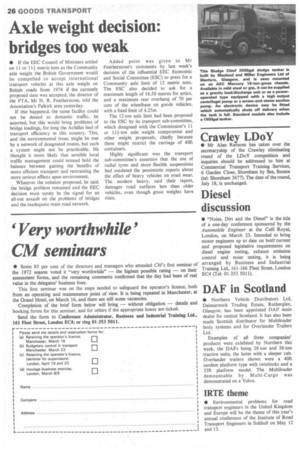Axle weight decision: bridges too weak
Page 28

If you've noticed an error in this article please click here to report it so we can fix it.
• If the EEC Council of Ministers settled on 11 or 11+ metric tons as the Community axle weight the British Government would be compelled to accept international transport vehicles at this axle weight on British roads from 1974 if the currently proposed date was accepted, the director of the PTA, Mr H. R. Featherstone, told the Association's Falkirk area yesterday.
If this happened, the same facility could not be denied to domestic traffic, he asserted, but this would bring problems of bridge loadings, for long the Achilles heel of transport efficiency in this country. This, and the environmental issue, might be met by a network of designated routes, but such a system might not be practicable. He thought it more likely that sensible local traffic management could instead hold the balance between gaining the benefits of more efficient transport and restraining the more serious effects upon environment.
Whatever the solution proposed, he said, the bridge problem remained and the EEC decision must surely be the signal for an all-out assault on the problems of bridges and the inadequate main road network. Added point was given to Mr Featherstone's comments by last week's decision of the influential EEC Economic and Social Committee (ESC) to press for a Community axle limit of 12 metric tons. The ESC' also decided to ask for a maximum length of 16.50 metres for artics, and a maximum rear overhang of 70 per cent of the wheelbase on goods vehicles, with a fixed limit of 4.25m.
The 12-ton axle limit had been proposed to the ESC by its transport sub-committee, which disagreed with the Commission's 11 or 111-ton axle weight compromise and other weight proposals, chiefly because these might restrict the carriage of 40ft containers.
Highly significant was the transport sub-committee's assertion that the use of radial tyres and more flexible suspensions had outdated the pessimistic reports about the effect of heavy vehicles on road wear. The modern heavy, said their report, damages road surfaces less than older vehicles, even though gross weights have risen.














































































































































